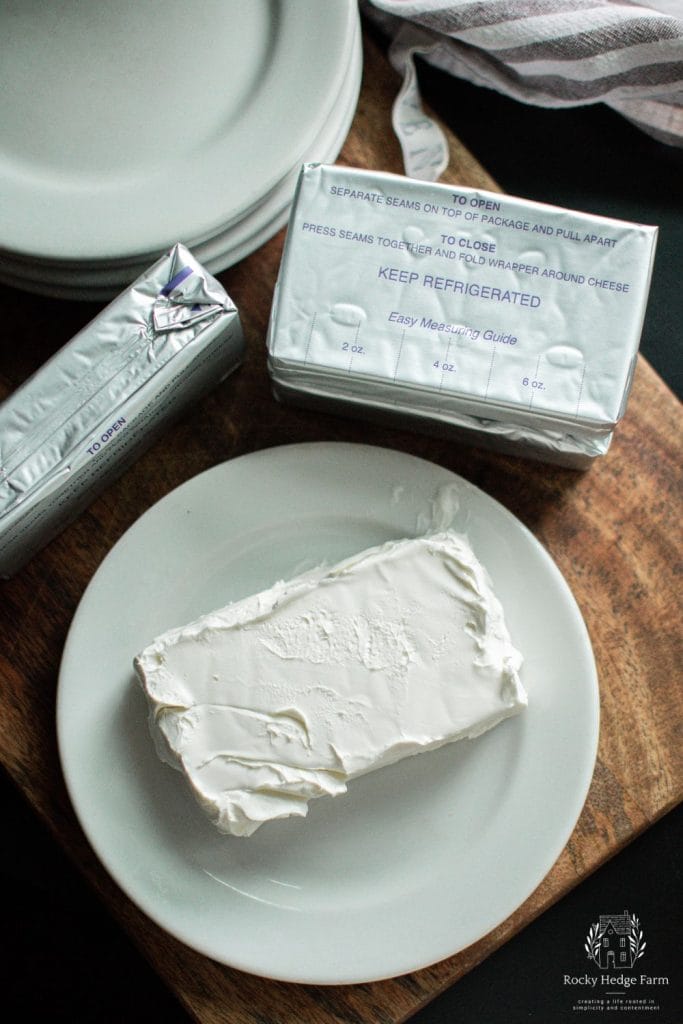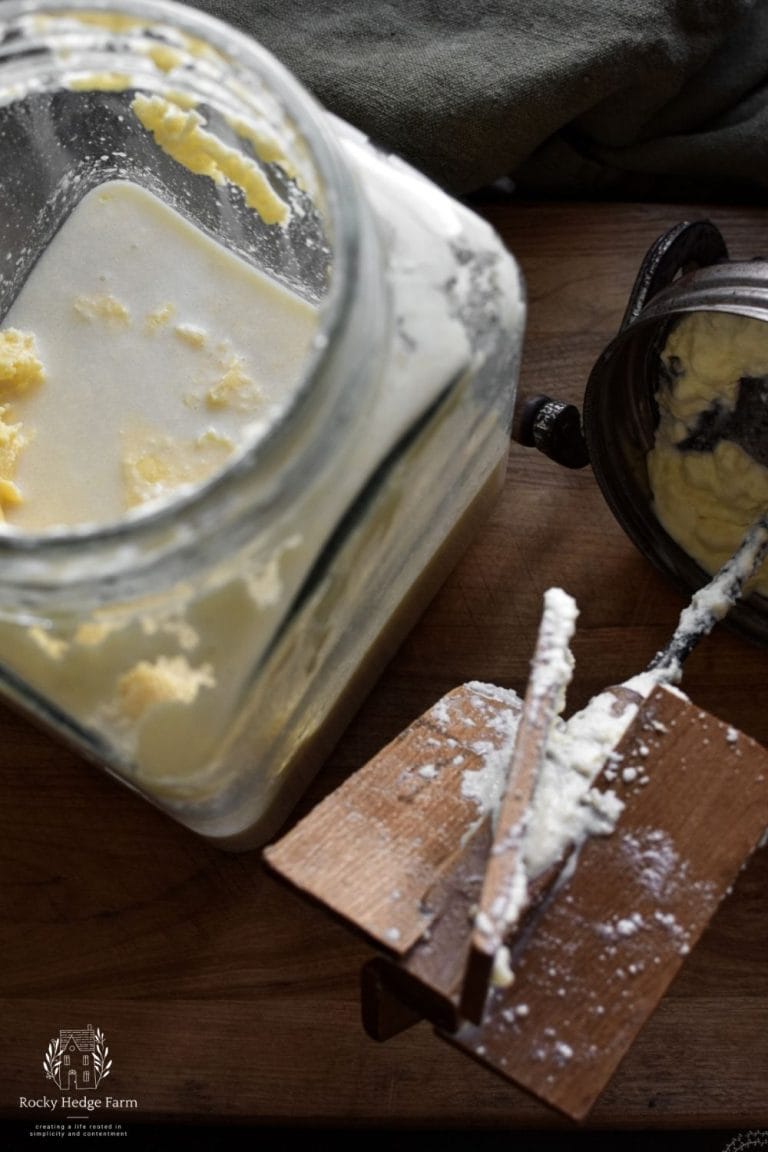How Long Can Cream Cheese Sit Out to Soften
How long can cream cheese sit out to soften without comprising its quality or safety? It’s a question that many home cooks ponder when a recipe calls for softened cream cheese.

There are few ingredients more beloved than cream cheese. Its soft texture and rich, tangy flavor have made it a staple in countless recipes, from cream cheese filling to classic homemade cheesecake, fruit dips, and cream cheese frosting.
Understanding how long a block of cream cheese can sit out at room temperature is essential to prevent the growth of bacteria and the risk of food poisoning.
In this blog post, I will talk about how long cream cheese can sit out safely, how to spot signs of spoilage, and how to store cream cheese.
By the end, you will have the information you need to keep your cream cheese fresh and delicious.
How Long Can Cream Cheese Sit Out?
Cream cheese can sit at room temperature for a maximum of two hours. After that time, it enters the danger zone where harmful bacteria can start to grow.
Factors such as ingredients, processing methods, packaging, and storage conditions affect its shelf life. Signs of spoilage include visual changes, texture changes, odor changes, and mold growth.
What is Cream Cheese?
Cream cheese is a type of soft cheese made from cow’s milk. It has a creamy and smooth texture with a mild and slightly tangy flavor.
Cream cheese is typically made by combining milk and cream, then adding lactic acid bacteria to acidify the mixture. This causes the proteins in the milk to coagulate, resulting in thick, spreadable cheese.
This cheese is known for its spreadability, making it a popular choice for bagels, sandwiches, and crackers. It can also be a base for dips, spreads, and creamy sauces.

How Long is Cream Cheese Good For?
An unopened package of cream cheese can typically stay fresh and safe to eat for two to three weeks past the expiration date printed on the packing.
The cream cheese box has a use-by date or sell-by date indicated on the package, providing guidance on its freshness.
Proper storage plays a significant role in extending the shelf life of cream cheese. Keeping the unopened pack of cream cheese in its original packaging will help maintain its freshness and quality for a longer duration.
It is important to note that this timeframe is a general guideline and may vary depending on the specific brand and quality of the cream cheese.
Shelf Life of Cream Cheese
Cream cheese is a perishable dairy product with a limited shelf life. When left unopened, cream cheese can usually remain good for approximately two to three weeks beyond the expiration date indicated on the packaging.
However, once opened, the shelf life of cream cheese decreases considerably. It is best to use the opened cream cheese within seven to ten days to maintain its freshness.

How to Tell If Cream Cheese is Bad
Determining if cream cheese has gone bad is crucial for ensuring food safety. Here are some signs of spoilage to look out for to determine if your cream cheese has spoiled.
Visual Changes
Check for mold growth on the surface of the cream cheese. Discard it immediately if you see any green, blue, or black spots.
Texture Changes
If the cream cheese appears excessively dry, crumbly or has any unusual slimy or sticky texture, it may be a sign of spoilage.
Odor Changes
Fresh cream cheese has a mild, slightly tangy smell. If you detect a sour smell or unpleasant odor, it could indicate spoilage.
Sour Taste
Taste a small amount of the cream cheese. If it has a noticeably sour or off taste, it is best to discard it.
Expiration Date
Check the expiration date on the packaging. If the cream cheese is past its expiration date, it may have gone bad.
Signs of Contamination
If the cream cheese has been exposed to cross-contamination with other foods, it is safer to discard it.
It is important to note that cream cheese should be handled and stored correctly to maximize its shelf life. If you are unsure about the quality or safety of the cream cheese, it’s best to err on the side of caution and discard it.

How to Store Unopened Cream Cheese
Proper storage of cream cheese is essential for maintaining its freshness and quality. Here are some guidelines on how to store cream cheese:
- Cream cheese should always be stored in the refrigerator. Storing it in the original cardboard packaging and foil wrapper is best.
- Cream cheese quickly absorbs odors, so storing it away from strong-smelling foods like onions and garlic is best.
- Avoid leaving cream cheese on the kitchen counter or at room temperature for extended periods, as it can promote bacterial growth and spoilage.
- If you have unopened cream cheese you won’t use before its expiration date, it is a good idea to freeze it.
By following these storage guidelines, you can extend the shelf life of cream cheese.

How to Store Opened Cream Cheese
To store opened cream cheese, follow these steps:
- Transfer any leftover cream cheese portions to an airtight container or resealable plastic bag.
- Ensure the container or bag is tightly sealed to prevent air and moisture from entering.
- Label the container with the opening date to keep track of its freshness.
- Place the sealed container in the refrigerator’s coldest section.
- Keep the cream cheese away from areas where it can be exposed to temperature fluctuations, such as near the fridge door.
- Use opened cream cheese within seven to ten days for optimal freshness and quality.
How Long Does Cream Cheese Take to Soften?
Cold cream cheese typically takes about 20-30 minutes to soften when left at room temperature. You can cut it into smaller pieces or cubes to speed up the process.
Another effective method is placing the cream cheese, still wrapped in foil, in a bowl of warm water.
If you want more detailed instructions on softening cream cheese, I invite you to check out my post, how to soften cream cheese.
You will find a comprehensive guide with step-by-step instructions and additional tips for achieving perfectly softened cream cheese.

FAQs
Can You Put Room Temperature Cream Cheese Back in the Fridge?
If you have a small amount of cream cheese left over, you can put it back in the refrigerator. Cover the cream cheese tightly with its original packaging or transfer it to an airtight container.
Can You Leave Cream Cheese Out Overnight to Soften?
Leaving cream cheese out overnight to soften is not recommended. Leaving cream cheese out at room temperature for an extended period creates an environment conducive to bacterial growth.
Does Cream Cheese Frosting Need to be Refrigerated?
According to food safety guidelines, cream cheese frosting and other foods containing cream cheese should be refrigerated within two hours of room temperature exposure.
Can You Freeze Cream Cheese?
Yes, you can freeze unopened packages of cream cheese. Freezing cream cheese is a great way to extend its shelf life.
However, it is important to note that the texture of thawed cream cheese may change slightly after freezing, making it more suitable for cooking and baking rather than spreading.

In Conclusion
Adhering to the two-hour rule and refrigerating cream cheese can help prevent the growth of harmful bacteria and ensure its freshness.
Leaving cream cheese at room temperature for more than a couple of hours provides a breeding ground for bacterial growth.
By following the recommended guidelines, such as refrigerating cream cheese promptly and being aware of signs of spoilage, you can enjoy this dairy product while minimizing the risk of foodborne illness.
Whether using cream cheese in spreads, dips, frostings, or baked goods, practicing good food safety habits will help you savor its creamy texture and delicious flavor.
So, next time you have a block of cream cheese, remember to store it properly to maintain its quality for using in all of your favorite recipes.
Related Posts:



